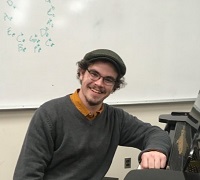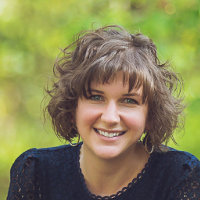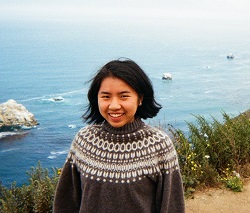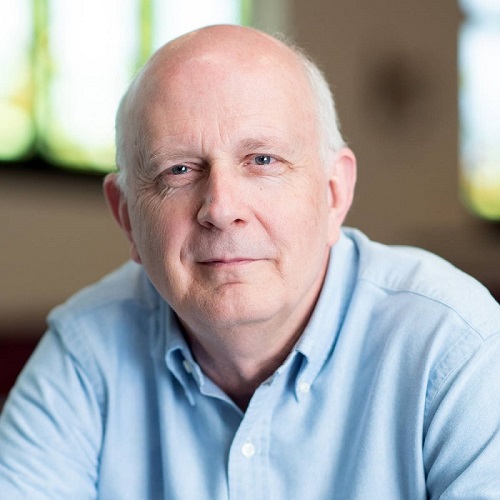Professor Daniel Bukvich Biography
Notes on Bukvich's early musical influence and training
Contents: Early Years | First Instructors | Montana State University | University of Idaho | Project Collaborators|Tech
This digital collection is a selection of works from the Professor Daniel Bukvich Collection at the University of Idaho Library’s Special Collections and Archives. These pieces were specifically curated by Bukvich himself to serve as an informed introduction to his music and be an open resource for researchers, composers, and musicians.
The digital collection was created with the assistance of Liam Marchant, a 2022 University of Idaho graduate, Music Composition Major, and Center for Digital Inquiry and Learning (CDIL) Fellow. To discover more about the pieces in this collection and the influences behind them, Marchant conducted a series of interviews with Professor Bukvich during the summer of 2022. The information from those interviews has been condensed into the bibliographic narrative below.
Early Years
Daniel Bukvich Jr. was born in 1954 in Butte, Montana. Bukvich’s early interest in music was heavily encouraged by his mother, who was a fan of jazz music and often surrounded young Bukvich with many recordings and opportunities to learn more about music. One of his earliest memories was being given a pair of bongos and a copy of the Stan Kenton Cuban Fire Suite by his mom. Bukvich can’t pinpoint exactly why he was gifted the pair of bongos but speculates it might have been because of his interest in rhythm. Possibly his mother was tired of hearing him bang on table surfaces or pots and pans. Difficult to say the specific exigence behind the gift, but his earliest memories were with this pair of bongos and subsequently, the start of his relationship with sound and rhythm.
Bukvich’s grandmother gave him a guitar when he was around 11 years old. This 1880’s Washburn parlor guitar was found in his great-grandmother’s basement and was once used in lieu of rent money around the year 1900. Bukvich attributes this gift, his continued support from his mother, and a developing interest in the piccolo as beginning his craft as a musician and composer.
First Instructors
Bukvich’s first formal music instructions were on the piccolo from Rod Lewis, a junior-high band director in Butte and a notable jazz guitarist in the area. Lewis found it interesting that an 11-year old would want to learn how to play the piccolo. In one of their first few lessons, Rod suggested that Dan should take a look at drums. And he eventually started taking drum lessons and playing in his junior-high band.
The same year, Bukvich’s mom died. In his grief, Bukvich found a further focus in his musical craft. Around this time he started taking lessons with Clarence “Mud” Thomas, who taught Bukvich how to read music. Together, Bukvich and “Mud” carefully and meticulously worked through Reed’s Syncopation Studies, Wilcoxon Studies, and Jim Chapin’s Independence for the Modern Drummer (a set of exercises that were speculated to be impossible upon its release). Bukvich would take violin lessons from Navy veteran and Band Director, Raymond Simms. Simms was very influential for Bukvich’s practice routine and studying sight reading. Bukvich also maintained a driven self study on classical guitar after being gifted a large number of classical guitar books from a lawyer who was killed in an airplane accident in Butte.
Bukvich recalls being taught extensively by his peers in the High School drumline, helping him recognize aspects of tension between his hands and refine his percussion skills. Bukvich also recalls being woken up in the middle of the night by his dad to watch Buddy Rich on television and study his technique.
Jane Pasco, the Butte Highschool Drill team instructor, was very influential on Bukvich’s compositional roots. Bukvich was once tasked with writing a drum cadence for the high school drumline. Following its performance, Pasco asked some difficult questions from Bukvich that would resonate with him throughout his career.
“What did you think of that performance, did it sound like it did in your head?” Pasco asked.
“Yes it did, it sounded like a drum cadence.” Bukvich replied.
“What instrument would make the least sense to write a drum cadence for?” Pasco probed.
Looking around the band room for a few seconds, Bukvich pointed at the chimes (tubular bells) at the edge of the percussion section in the band room.
“That’s why you should write a drum cadence for chimes.” Pacso replied.
This interaction would stick with Bukvich for a very long time and influence much of his compositional interest. By leading with exploration and experimentation, you can invent new ways that instruments might be utilized by themselves or in a larger ensemble. This interaction inspired the chimes cadence that is featured in Agincourt Hymn.
As Bukvich worked more on solidifying his percussion technique, he began to explore the world of composition more with encouragement from mentors like Jane Pasco. His compositional interests would eventually take him to Montana State University in Bozeman.
Montana State University
Ray Simms, upon hearing Bukvich’s interest in studying composition, took him to Montana State University (MSU) in Bozeman, Montana. There, he interviewed with Creech Reynolds and agreed to study at Montana State but not major in music. He wanted to increase his efficiency and refine his theory and compositional chops in school and then return back to Butte and work at his father’s office and work for the Clerk of Courts in Silverbow County while writing music at night. His plans changed when he met his mentors at Montana State. Bukvich recalls one of his teachers, Lowell Hickman, expressing that he could receive an Ivy League level of education while at MSU if he was smart enough to ask the right people the right questions. He recalls that Carl Lovitz (director of bands), Lowell Hickman (choirs), Mary Sanks (composition and theory), Henry Campbell (composition and theory), Creech Reynolds (music department director and composition instructor), Dushan Voinovich, Dorothy Kim, Ed Cedivy, Karen and Ellen Leech, Charles Payne, and Larry Sawel all had a very big role in his college education.
Bukvich recalls not really paying any mind to a degree program while at MSU, rather he took classes and lessons that his professors and colleagues recommended he take. His time as a percussion student, under the instruction of Ed Cedivy. Cedivy’s percussion connections from his time at Julliard enabled Bukvich to connect with specialists across several percussion disciplines.
Louie Belson, the drummer of the Duke Ellington band, was a featured guest at MSU in January of 1974. Belson taught Bukvich several new drum set techniques and facilitated his compositional goals. Belson introduced Bukvich to the “Ellington Chord” which is a C triad with a D-flat above the low C. This structure became the cell basis for Bukvich’s Symphony No. 1 for Band in his masters thesis. Belson was slated to introduce Bukvich to Ellington later that year, but Ellington died weeks before the day they would meet.
Bukvich graduated from MSU with a degree in Music Education in 1976, the only music degree offered at MSU at the time. During his time at MSU, he had conducted a percussion ensemble which had grabbed the attention of Professor Robert Spevacek, at the University of Idaho (U of I). Spevacek was in need of a graduate percussion TA to run percussion ensemble. Spevacek further influenced Bukvich’s decision to come to the University of Idaho by introducing him to William Billingsly who would be one of Bukvich’s most influential composition mentors.
University of Idaho
Upon coming to U of I, Bukvich was soon given the job of directing the marching band. Bukvich recalls having no initial interest in directing the group but that the job eventually transformed into a 10-year composition lesson. During this time he ended up on the faculty at the U of I in 1977, where his teaching duties now include the percussion studio, first year music theory and aural skills, and jazz choirs.
After 15 years of being at the U of I, Bukvich was encouraged by Music professors William Billingsly and Ronald Klimko to re-develop an aural skills and theory program. He recalls Billingsly advising him to “find out what everyone else is doing and don’t do it.” Bukvich claims that to this day, the class’s curriculum is still changing, the goals haven’t changed but the methods certainly have.
Project Collaborators



Technical Credits - CollectionBuilder
This digital collection is built with CollectionBuilder, an open source tool for creating digital collection and exhibit websites that is developed by faculty librarians at the University of Idaho Library following the Lib-STATIC methodology.
Using the CollectionBuilder-CSV template and the static website generator Jekyll, this project creates an engaging interface to explore driven by metadata.

